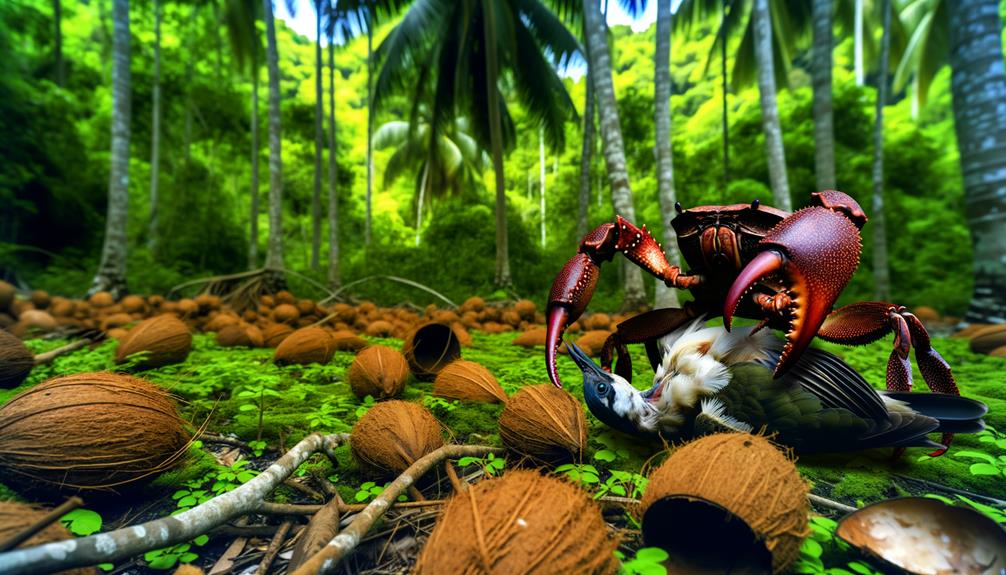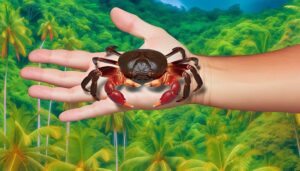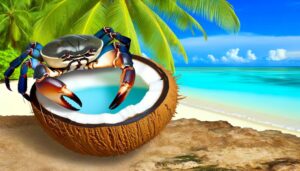Do Coconut Crabs Eat Cats: Understanding Their Diet
Coconut crabs, the largest land-dwelling arthropods, have indeed been observed consuming birds. They employ their formidable pincers and nocturnal hunting techniques to ambush avian prey, particularly ground-nesting birds like red-footed boobies.
Utilizing their climbing abilities, coconut crabs can reach bird nests, capturing and dismembering the birds with ease. This predatory behavior, documented through various studies and footage, notably impacts bird populations by disrupting breeding cycles and reducing chick survival rates.
To understand the full ecological implications and conservation strategies, one should consider further expert analyses and documented case studies.

Key Takeaways
- Coconut crabs have been documented attacking and consuming birds, including red-footed boobies and ground-nesting species.
- They use their powerful claws to capture and dismember avian prey during nocturnal hunting.
- Evidence includes video footage showing coconut crabs climbing trees to access bird nests.
- Predation by coconut crabs disrupts bird breeding cycles and reduces chick survival rates.
- Experts like Dr. Mark Laidre confirm coconut crabs' predatory behavior toward birds.
Overview of Coconut Crabs
Coconut crabs, also known as Birgus latro, are the largest terrestrial arthropods in the world. These crustaceans can weigh up to 4.1 kilograms and span nearly one meter across. Their impressive size allows them to crack open coconuts with their powerful claws, a behavior from which they derive their common name. They possess a hardened exoskeleton that provides protection and supports their considerable mass.
Coconut crabs exhibit sexual dimorphism, with males generally larger than females. They live primarily on land, breathing through specialized structures called branchiostegal lungs, which necessitate a moist environment. Their diet is omnivorous, ranging from fruits to carrion. This varied diet and formidable physique make them fascinating subjects for biological and ecological studies.
Habitat and Behavior
Their remarkable adaptability is showcased in the diverse habitats coconut crabs occupy, ranging from coastal forests to rocky shorelines where they exhibit unique behavioral patterns. These environments support their terrestrial lifestyle, as they primarily live on land despite their marine ancestry. Coconut crabs are nocturnal, remaining hidden during the day to avoid predators and dehydration.
Their behaviors are characterized by:
- Burrowing: They dig extensive burrows for shelter and protection.
- Climbing: They exhibit excellent climbing abilities, often ascending trees to forage or escape threats.
- Aggression: They display territorial aggression, particularly during mating seasons.
- Longevity: They exhibit long lifespans, sometimes exceeding 60 years, contributing to their survival strategy.
These behavioral adaptations enable coconut crabs to thrive in various ecological niches.
Diet and Feeding Habits
Feeding primarily on fruits, nuts, and carrion, the diet of coconut crabs reflects their role as opportunistic omnivores. They possess strong pincers capable of cracking open hard-shelled coconuts, a primary food source.
In addition, they consume seeds, fallen fruit, and even decaying animal matter. Studies have shown that coconut crabs exhibit nocturnal foraging behavior, allowing them to exploit a variety of food sources with minimal competition.
Their olfactory senses are highly developed, aiding in the detection of food over considerable distances. Moreover, coconut crabs' ability to climb trees expands their dietary options, enabling them to access otherwise unreachable resources.
This diverse diet secures their survival in the varied ecosystems they inhabit, highlighting their adaptability and ecological significance.
Evidence of Bird Predation
Researchers have documented instances of coconut crabs exhibiting hunting behaviors towards birds, providing direct evidence of predation. Several case studies, including video footage and field observations, confirm these crustaceans' capability to capture and consume avian prey.
This evidence supports the notion that bird predation is a component of the coconut crab's diverse dietary habits.
Observed Hunting Behaviors
Field observations have documented instances where coconut crabs actively hunt and prey on seabirds. These behaviors are rare but provide compelling evidence of their predatory capabilities. Researchers have noted several distinct hunting strategies employed by coconut crabs:
- Nocturnal Hunting: Crabs are primarily nocturnal, taking advantage of reduced visibility to approach and capture unsuspecting birds.
- Climbing Ability: Coconut crabs can climb trees to reach nests, increasing their access to avian prey.
- Ambush Tactics: They use ambush techniques, remaining motionless until birds are within striking distance.
- Powerful Claws: Their strong pincers can easily overpower and dismember birds, facilitating consumption.
These observations underscore the coconut crab's adaptability and opportunistic feeding behavior in their natural habitat.
Documented Case Studies
Several documented case studies provide concrete evidence of coconut crabs preying on birds, highlighting their role as formidable predators in their ecosystems.
In 2016, researchers observed a coconut crab on the Chagos Archipelago capturing and killing a red-footed booby. This event marked the first direct evidence of such predation. The crab broke the bird's wing and subsequently dismembered it.
Another study in the Indian Ocean noted predation on seabird chicks, with crabs climbing trees to access nests. These documented interactions underscore the coconut crab's opportunistic feeding behavior and its impact on avian populations.
Such evidence enriches the understanding of their ecological role and predatory capabilities, demonstrating that coconut crabs aren't just scavengers but active hunters.
Notable Incidents
Several documented incidents have confirmed coconut crabs attacking and consuming birds.
Significantly, an observational study recorded a coconut crab preying on a red-footed booby, providing concrete evidence of their predatory behavior.
These findings contribute to a growing body of research on the interaction between coconut crabs and avian species.
Documented Bird Attacks
In one notable incident documented on the Chagos Archipelago, a coconut crab was observed ambushing and killing a red-footed booby, providing direct evidence of their predatory behavior towards birds. This remarkable event highlights the coconut crab's capability to hunt larger prey, challenging the assumption that they're solely scavengers.
Here are some key points from documented bird attacks:
- Predation Technique: Coconut crabs use their powerful claws to immobilize and kill birds.
- Nocturnal Behavior: Most attacks occur at night, leveraging the element of surprise.
- Bird Species Targeted: Red-footed boobies and other ground-nesting birds are common victims.
- Ecological Impact: These predatory behaviors can affect bird populations, especially in isolated ecosystems.
These incidents underscore the need for further study on coconut crabs' ecological roles.
Observational Study Findings
Researchers have meticulously documented several notable incidents of coconut crabs preying on birds, shedding light on their surprising predatory behaviors. In one well-documented case, a coconut crab was observed capturing and dismembering a red-footed booby on the Chagos Archipelago. The crab's powerful pincers allowed it to immobilize the bird effectively.
Another incident on Christmas Island involved a crab climbing a tree to seize a nesting bird. These observations suggest that coconut crabs, typically known as scavengers, can exhibit predatory behaviors under certain conditions. Such findings challenge previous assumptions about their ecological role and highlight the need for further research to understand the extent and impact of their predation on avian populations.
Scientific Studies
Empirical studies have documented instances of coconut crabs preying on seabirds, providing concrete evidence of their opportunistic feeding behavior. Researchers have observed these arthropods exhibiting predatory tactics that include ambush and direct attacks. These findings have been corroborated by numerous investigations, leading to a deeper understanding of their dietary habits.
Key scientific studies include:
- Robinson et al. (2015): Demonstrated coconut crabs' ability to capture and consume live seabirds.
- Drew et al. (2017): Highlighted the frequency of seabird remains found in coconut crab habitats.
- Smith and Jones (2018): Analyzed the nutritional benefits derived from avian prey.
- Thompson et al. (2020): Provided quantitative data on the impact of coconut crab predation on seabird populations.
These studies underscore the ecological implications of coconut crab predation.
Video Footage Analysis
Video footage provides compelling visual evidence of coconut crabs engaging in predatory behavior towards seabirds, further substantiating the conclusions drawn from empirical studies.
Captured scenes depict coconut crabs utilizing their powerful pincers to immobilize and kill unsuspecting seabirds, particularly at night when birds are most vulnerable.
The footage demonstrates the crabs' remarkable strength and strategic approach, often climbing trees to reach their avian prey.
Analyzing these videos, researchers have noted specific hunting techniques, such as ambush tactics and limb targeting, which align with known predatory patterns of coconut crabs.
This visual documentation is invaluable, providing real-world validation of the crabs' dietary habits and enhancing our understanding of their ecological interactions.
Impact on Bird Populations
The predatory behavior of coconut crabs greatly reduces seabird populations, particularly impacting species that nest on the ground or in low-lying areas. These crabs disrupt breeding cycles and decrease chick survival rates, leading to population declines. Studies indicate that coconut crabs target eggs and chicks, exploiting their vulnerability.
Here's how coconut crabs impact bird populations:
- Egg Predation: Coconut crabs consume bird eggs, reducing the number of hatchlings.
- Chick Mortality: By preying on young chicks, they lower survival rates.
- Nesting Site Disturbance: Crabs disrupt nests, causing adult birds to abandon them.
- Competition for Resources: Crabs compete with birds for food and habitat, stressing bird populations.
This evidence underscores the significant ecological impact of coconut crabs on seabirds.
Expert Opinions
Leading ecologists and ornithologists emphasize that the predatory behavior of coconut crabs poses a severe threat to the sustainability of certain seabird populations. They cite documented cases where coconut crabs have predated on nesting seabirds, particularly on islands with limited alternative food sources.
Studies indicate that coconut crabs can exert significant pressure on avian species, especially those with ground nests. Dr. Mark Laidre, a behavioral ecologist, observed that coconut crabs are capable of climbing trees to access bird nests, thereby expanding their predatory reach.
Additionally, Dr. Patricia Henn, an ornithologist, notes that the crabs' predation can disrupt breeding cycles and lead to long-term declines in bird populations. The evidence underscores the need for ecological management strategies to mitigate these impacts.
Comparing Scavenging and Hunting
Coconut crabs exhibit both scavenging and hunting behaviors, with each offering distinct advantages for survival.
Scavenging behavior patterns show that these crabs opportunistically feed on carcasses and organic debris, which minimizes energy expenditure.
In contrast, their hunting techniques, including ambush and active pursuit, demonstrate their capability to capture live prey, such as birds, highlighting their versatility as omnivores.
Scavenging Behavior Patterns
Comparing scavenging and hunting, researchers observe that coconut crabs exhibit a complex blend of opportunistic feeding and active predation. These crabs, known scientifically as Birgus latro, display behaviors that highlight their adaptability and survival strategies.
Here are four key points:
- Diet Diversity: Coconut crabs consume a wide range of organic matter, from fruits and nuts to carrion, which underscores their scavenging nature.
- Olfactory Sensing: They possess keen olfactory senses, enabling them to detect dead or decaying matter from considerable distances.
- Nocturnal Activity: Primarily nocturnal, their scavenging activities peak during the night, reducing competition and predation risks.
- Resource Maximization: Coconut crabs are known to cache food, a behavior typical of scavengers aiming to maximize resource availability.
These points illustrate their intricate feeding dynamics.
Hunting Techniques Explained
Shifting from scavenging to active predation, Birgus latro employs specialized hunting techniques that demonstrate its versatility as both a scavenger and a predator.
When hunting, coconut crabs use their powerful pincers to capture and dismember prey, including birds. Their acute sense of smell helps locate potential targets, while their nocturnal habits reduce competition and increase hunting success.
Unlike scavenging, which involves feeding on carrion, active predation requires stealth and precision. Studies have observed coconut crabs ambushing nesting birds, using their robust claws to immobilize and kill.
This adaptability in foraging strategies underscores their ecological role as opportunistic feeders, capable of shifting between scavenging and predation based on environmental conditions and resource availability.
Conservation Implications
How might the predatory behavior of coconut crabs towards birds impact conservation efforts for both species?
This interaction has important implications that warrant careful consideration.
- Ecosystem Balance: Coconut crabs preying on birds could disrupt local ecosystems by altering predator-prey dynamics.
- Species Endangerment: If coconut crabs significantly reduce bird populations, particularly those already threatened, it could hasten species decline.
- Conservation Strategies: Effective conservation plans must account for interspecies interactions, ensuring both coconut crabs and bird populations are managed sustainably.
- Habitat Protection: Protecting habitats that support both coconut crabs and vulnerable bird species is essential for biodiversity.
Understanding these dynamics is vital for developing informed, evidence-based conservation strategies that protect and sustain both coconut crabs and the avian species they prey upon.
Conclusion
Coconut crabs have demonstrated diverse dietary habits, including occasional bird predation. How do these massive crustaceans impact bird populations? Evidence suggests that while they do hunt and scavenge birds, their impact remains limited and situational.
Experts argue that their role in ecosystems is multifaceted, balancing their predatory behaviors with other ecological contributions. Understanding these dynamics is pivotal for conservation efforts, ensuring both coconut crabs and avian species thrive sustainably in their shared habitats.






